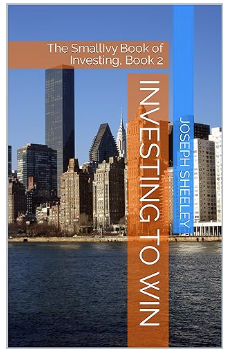
The truth is, the steps to reaching financial stability are pretty simple. People just tend to make personal finance complicated. Today we’ll talk about the four steps to reaching financial stability and then financial independence. (To be stable is to have all of your bills covered, both now and in the relatively near future. To be financially independent is to not need to worry about being able to cover your bills whether you work or not.)
These four steps are:
- Create an income that exceeds your basic needs.
- Maximize your free cash flow.
- Use free cash flow to save up for things that you’ll need.
- Invest the excess and create a financial feedback loop.
Let’s go through each of these steps and provide details on how you can implement them in your life.
(Note, this site contains affiliate links. As an Amazon Associate I earn from qualifying purchases. When you click on an affiliate link and buy something, The Small Investor will get a small commission for the referral. You are charged nothing extra for the purchase. This helps keep The Small Investor going and free. I don’t recommend any products I do not fully support. If you would like to help but don’t see anything you need, feel free to visit Amazon through this link and buy whatever you wish. The Small Investor will get a small commission when you do, again at no cost to you.)

Step 1: Create enough income
The first step is to create enough income to meet your basic needs and then have at least some money left over. If you’re not meeting your needs, you will go into debt and eventually face bankruptcy. If you’re just meeting your needs, you’ll survive but never have enough to retire and be struggling to cover things your whole life. There is no magic cure for not earning enough money to cover the basics.
Luckily, it is actually fairly easy to meet basic needs today in our free enterprise society. For a single person, even entry level jobs will pay enough to cover the basics. Sure, you might have a small apartment or share a basic place with a roommate or two, but you can generate enough for shelter, food, basic medical care, clothing, and modest transportation. If two people are sharing living costs, if each works at least an entry-level job, they should be able to cover the basics for both of them. Being married allows the couple to safely support each other and can make their financial situation even better. (Part of this is letting one person provide for critical needs directly like childcare, home repair and home sanitation, as well as doing tasks like preparing meals so that less money must be made and paid to others outside of the family to meet these needs.)
To go beyond the basics and have some money left over, as is our goal, requires moving up beyond entry level jobs. This happens by being valuable while at work (doing your job and spending your time doing useful things) and also learning skills to become more valuable so you can do work that is beyond entry-level. Learning these skills may involve formal paid training, such as college or trade schools. It could be short courses or training that is offered through your employer or at a new job where they hire and then offer training to let you learn the skills that they need you to have. It could be simply gained by reading books or watching YouTube videos at home or doing things on-the-job with a mentor who can teach you the needed skills.
As you learn skills and become more valuable, you will be able to earn more per hour. This may be at your current employer, or it may require that you change employers to get into a role that will let you use your skills and be compensated appropriately for having them. You should always be looking for opportunities and weighing the benefits of staying where you are to changing jobs for greater opportunities. There are certainly benefits to staying with a company and building up experience in their culture and processes, but often you must move on because the opportunities are just not available where you are. Moving into management, where you are directing people, is also a way to increase your income. Of course, managing people is a special skill that will take experience as well as training. There is also a natural ability involved.
Doing side jobs or “side hustles” is another way to increase your income. These are things like mowing a few lawns on the weekends or watching a child for a two-worker family during the week, selling things on Ebay or Etsy that you find or make, or even running a small business during your off-hours. These will involve spending more hours working, as opposed to increasing how much you are paid for the hours you work, but can be very profitable per hour and certainly will add to your income. It might be that your job covers your needs and then your side hustles provide the income you need to save and invest.
The SmallIvy Book of Investing: Book1: Investing to Grow Wealthy

SmallIvy Book of Investing: Book1: Investing to Grow Wealthy
Step 2: Maximize Free Cash Flow
Cash flow is how money comes into your life and your bank accounts and then is spent, saved, invested, or given away. Free cash flow is money left over after you have paid for everything you are obligated to pay. Obligations are things like apartment rents, car payments, child support, and phone bills. These are things that you are required to pay or you’ll face consequences like financial penalties, jail time, or a ding on your credit score.
Your free cash flow is available to pay for your needs like clothing and food. Once you have covered your needs, it can then be used to save up for things like your next car or a replacement refrigerator. Your needs can be met with different levels of costs. You can buy clothing new in a boutique or used in a thrift store or a thousand other ways in between these extremes. You can eat within a range of options as well, from eating out at a fine steakhouse each night to eating Raman noodles at home.
Maximizing free cash flow involves both maximizing your income, using the methods described in the last section, along with minimizing your obligations. Examples of the latter:
- Buying a less expensive home or renting a cheaper apartment.
- Buying a used car for cash rather than buying new and creating car payments.
- Going without a subscription to a streaming service.
- Not signing up for a time share which then obligates you to pay maintenance fees and a yearly use cost.
- Not putting things on credit cards that you can’t afford now and then needing to pay monthly interest and minimums.
Certainly you can spend all of your free cash flow each month if that is what you choose to do. Having a large free cash flow, however, gives you the opportunity to save. Because the money is not obligated to things, you can choose to spend less and put money into savings. You can find the money to put into a 401k plan or an IRA for your retirement. You can start saving up for a new roof. Unless you have free cash flow, you don’t have the ability to do these things because you have no money left over. It’s all spoken for before the month starts. Having free cash flow gives you something to work with and build wealth.
If you find you have no free cash flow, look for ways to increase it. Can you move up at work or get a better job? Can you or your spouse take on a second job (or a first job)? Is there a side hustle you can do to add some income? Is it time to sell a car and get rid of a car payment? (Could you go without a car entirely?!) Can you really focus your spending and pay down and pay off a credit card? What works for you is a personal choice and based on your personal situation. But gaining free cash flow is needed before you can advance financially.
Before you can start investing, you need money to invest. Check out FIREd by Fifty: How to Create the Cash Flow You Need to Retire Early. You’ll learn how to control your cash flow so that you’ll have money to invest and grow wealth.

Step 3: Use Free Cash Flow to Save Up
This is where you go from being average with money to being exceptional. And when you’re exceptional, you’ll actually have more money to use over your lifetime than others. And what do you do exactly?
You use the free cash flow that you have to save up and pay cash for things.
Most people will spend everything they make each paycheck. They feel like as long as they’re covering their bills, they are doing well. But then things happen. A car breaks down. The roof needs to be replaced. The water heater goes. When these things happen, they take out a loan from the bank or pull out the credit cards and start to erode their free cash flow. Not only that, but they will often pay more this way for things and end up paying interest. This means that they don’t get to use all of their money to obtain things. Part of it is spent on interest and depreciation.
If you can save up and buy things for cash:
- You may get a cash discount.
- You’ll be able to buy used for things like cars from private owners and save a ton on depreciation and dealer mark-ups.
- You’ll avoid interest payments.
Saving up and paying cash will result in a savings of thousands of dollars over your lifetime. Having free cash flow gives you the ability to save up. Controlling your spending so that you can save some of that free cash flow means that you’ll actually have the cash you need to buy things when you need them.
How much do you need to save up each year? Just think about the things that you will need and estimate how long it will be before you will need to replace them. Say you have a $6,000 roof that will need to be replaced in 15 years. That’s $6000/15 = $400/year or about $34 per month you’ll need to save.
You can make a list of all of the things you’ll need to replace and estimate when and then add it all up to figure out the total amount you should be putting away from free cash flow each month. Put this amount away before you spend money on other things and you’ll be likely to actually have the money you’ll need when things need to be replaced. And don’t forget that you’ll want to be retired some day and be putting money away for that.
Step 4: Invest the excess
OK, so you’re saving up money for things like a roof you won’t need for 15 years and retirement that will not occur for forty years. Insurance companies do the same thing: collect premiums based on how likely they think it will be that they will need to pay out each year and then hold onto the money until a claim is made. What do they do with those premiums between home fires or major disasters? They invest the money and make money on the money they are saving until they need to pay out. They then are able to pay the claims and have a lot of additional money left over. The returns on investments are actually how they make their profits. The premiums people buying policies pay just pay for the salesmen salaries/commissions and cover the claims that are made.
You can do the same thing. Investing for retirement isn’t just smart, it’s really necessary. The amount you’ll need in retirement is way more than you’ll probably be able to save (unless you have a huge income and, therefore, a huge amount of free cash flow). But if you invest the money, you can actually get to the point where you’ll be able to retire at 55 to 65 and live another 30 to 40 years on the income your investments generate. As long as you manage your money properly in retirement, you’ll probably even have a bunch left over to leave to your children and grandchildren.
You can also invest money that you don’t need for at least a few years. This is especially true if you’ll see the need for the expense coming and are able to be somewhat flexible. If you’ve just bought a car and won’t need to replace it for 6 to 8 years, you certainly can invest the money you’re saving for the next one. (Note, your coworkers would be sending that money to a lender for car payments each month). You can watch the mileage you have on the car you’re driving and see things like how much oil it is burning between oil changes. You can know when it’s starting to get towards the end of life and start to shift money out of investments and into cash in preparation for the purchase.
You can also see how old your roof is getting and perhaps fix a leak or two to keep things going another year or two. The AC will probably be causing issues and give you some warnings before it needs to be replaced entirely. Most things can be repaired to extend their lives a year or two.
When you’re saving up for several things (remember your list you made in the previous step), you will also have things that are years away on the list. This means you’ll have more in savings than you need “right now” to cover things that are likely to break “right now.” You can therefore be investing some of the money but still have enough in cash to cover the things that do break unexpectedly. You might even be able to cover some of the things with just the cash you’re saving each month.
How do you invest the money exactly? This article isn’t meant to cover how to invest, but there are many such articles on The Small Investor. Be sure to look through the archive. In addition, the book Sample Mutual Fund Portfolios provides sample portfolios of mutual (index) funds that can be used in deciding how to invest for a variety of purposes.
Want to learn even more? If you really want to learn about investing, including how to invest in individual stocks and increase your returns, check out Investing to Win. Here I provide my strategies from forty years of investing in stocks and other assets.
(If you’d like to learn more about how to decide how much you should put in different types of assets, Sample Mutual Fund Portfolios gives lots of information and examples of how to make allocations for all sorts of different goals, including retirement.)

Want to learn the secrets to investing and really turbocharge your returns? Check out the second book in The Small Investor series, Investing to Win. This book presents 40 years of investing experience. Someone starting with zero knowledge of investing and the stock market could take this book and learn all that they needed to invest and do well. It would also be useful to someone who has invested and traded stocks for a while but who is really not getting the kind of returns desired.

Investing to Win
Have a question? Please leave it in a comment. Follow me on Twitter to get news about new articles and find out what I’m investing in. @SmalllIvy_SI
Disclaimer: This blog is not meant to give financial planning or tax advice. It gives general information on investment strategy, picking stocks, and generally managing money to build wealth. It is not a solicitation to buy or sell stocks or any security. Financial planning advice should be sought from a certified financial planner, which the author is not. Tax advice should be sought from a CPA. All investments involve risk and the reader as urged to consider risks carefully and seek the advice of experts if needed before investing.
